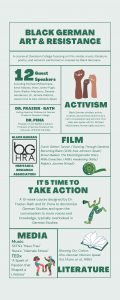Kari Gutmann
Course Reflection:
BLACK GERMAN ART & RESISTANCE
 DOWNLOAD INFOGRAPHIC
DOWNLOAD INFOGRAPHIC
Black German Art & Resistance explores literature, music, film, poetry, theatre, and activism that has been written, created, performed, influenced, and enacted by Afro- and Black-Germans. This incredibly unique course is taught by Dr. Emily Fazier-Rath, Visiting Assistant Professor of German Studies at Davidson College, and Dr. Rosemarie Peña, president and founder of the Black German Heritage and Research Foundation (BGHRA) and Adjunct Professor of German Studies in the Department of Central, Eastern, and Northern Europe at the University of British Columbia-Vancouver. The bulk of the curriculum revolves around weekly guest lectures from voices such as Dr. Michael McEachrane, Jamele Watkins, Imani Jones-Pugh, Dr. Natasha Kelly, and many others. By bringing in many Black German voices, this class challenges our understanding of knowledge and expectations of higher education, while decolonizing German Studies.
To kick off this course, Dr. Frazier-Rath and Dr. Peña focused our discussions mainly on the BGHRA and German diaspora around the world. This way the class can toggle with what it means to be “German” and challenge the status quo of German Studies. The examination of German imperialism and German colonies directly follows this discussion, framing our understanding of origin of Black Germans. Students read texts like “Advertising Chocolate, Consuming Race? On the Peculiar Relationship of Chocolate, German Colonialism, and Blackness” (Hackenesch) and “Making Visible the Invisible: Germany’s Black diaspora, 1880s-1945” (Aitken) as a basis for early Black German history. Aitken’s timeline of the Black diaspora from Imperial Germany through the Weimar Republic and all the way up to Nazi Germany provides the background information required to understand the remainder of the course. This unit also includes one of my favorite articles from the semester, Hackenesch’s examination of the relationship between chocolate as a colonial by-product and the use of Afro-Germans in the marketing and exotification of chocolate and the German colonies. An alternative to Hackenensch’s or Aitken’s work that I propose to be focused on as an alternative or supplementary text is Yara-Colette Lemke Muniz de Faria’s “Black German ‘Occupation’ Children: Objects of Study in the Coninuity of German Race Anthropology” to discuss the construction of race before and after World War II. The construction of race is pinnacle to the entirety of this course that must be addressed directly, instead of just focusing on racism and its effects in a Black German context.
The racism embedded in the marketing of chocolate framed our first guest lecture featuring Dr. Michael McEachrane wonderfully.
Dr. McEachrane, a human right’s activist and co-founder of European Network of People of African Descent (ENPAD) and the the Co-initiator of the Being Black in the EU (2018), has taken part in numerous UN reports and European Parliament resolutions fighting for racial justice and equality. As a class we read some of Dr. McEachrane’s works such as, “Pan-Africanism and the African Diaspora in Europe”. His focus on African diaspora in Europe connected the past and the present diaspora and racism, bringing together students’ current Black Lives Matter activism and other political issues and the imperial diaspora history we had just discussed prior. While Dr. McEachrane’s work can be applied to any point of this course, I think speaking with him at the end of the course could have proven to be more beneficial, as we could have related all that we have learned about Black German Studies to the African diaspora, as well as further discussed his political activism in the Black Lives Matter movement. McEachrane’s focus on the Black German and Black European diaspora allowed the class to contextualize Black German Studies in a large setting of activism, art, and resistance. That said, McEachrane proved to be a successful bridge into discussing Black Germans during the Interwar period, as immigration proved to be more prominent than ever in our discussions.
The Interwar period and the Nazi era meant complicated and conflicting implications for Black Germans, as national powers could not agree on the perception of Black people in Germany. Students watched Majub’s Journey (Knopf), a film about a Black man living in Nazi Germany during the 1930s, working as an extra in the film industry and as a soldier in German West Africa. Students also learned about the French Occupation of the Rhineland following the Treaty of Versailles and the subsequent racism towards Black Germans in the area. Videos featuring Theodor Wonja Michael
and Marie Nejar Engl
from Schwarz Rot Gold TV aided in the depiction of life and racism during Nazi Germany and the conflicting perceptions of Blacks by the Nazi party.
The Interwar period and Nazi era directly fed into our discussion of identity, transnational adoption, and continued Black diaspora. With Black soldiers ever present in Germany after the Second World War, many German women fell in love with Black soldiers resulting in the creation of the term “Brown Babies” or “war babies”. Many of these children were forced to be put up for adoption in the United States. Students watched Brown Babies: The Mischlingskinder Story, a film depicting the stories of the biracial children following WWII. Student’s spoke with Dr. Rosemarie Peña, Doris Walker-Mayberry, and Denese Henderson
about their experiences as postwar Black German transnational adoptees. Doris and Denese are wonderfully friendly and generous enough to open our eyes to their own identity struggles stemming from their transnational adoption as children. Students also spoke with Amal Abbass
,
certified Child, Adolescent, and Family Psychotherapist, entrepreneur, community-builder, artist, and poet. Amal Abbass’s discussion with our class proved to be incredibly influential, as many students connected with her work on a deeper level, choosing to further our dive into our discussion with Amal Abbass in their final projects. The study of postwar adoptees and their experiences is typically overlooked especially in a Black German Studies context, so the discussion of such proved to be critical in our examination of Black Germans during the Nazi era, World War II, and after.
We continued to examine film, music, media, literature, and poetry created by Black Germans, bringing our course to a more contemporary context. As a class, we dove into Black German hip-hop listening to artists like SXTN and Nura. We also spoke with Dr. Jamele Watkins
expert on the intersectionality of Black/African Diaspora Studies, Performance Studies, and German Studies, on her work “Afrolocken: Natural Hair in German Literature and Media” and what it means to be Black in German media and literature, especially pertaining to one’s natural hair. Discussing SXTN and Nura was refreshing, as many students could easily relate and find interest in German hip-hop, comparing it to popular artists in the United States. Filmmakers and performers, Dr. Layla Zami and Oxana Chi
came to talk to the class about their film Durch Gärten Tanzen / Dancing Through Gardens, a film about a woman’s stuggle, Tatitana Babakoff, through dance. We also met with Ines Johnson-Spain
, a German/Togolese filmmaker, and watched her film Becoming Black. While both films were wonderful and I am grateful to have met with such amazing creators, this course could be more effective with a brief overview of the themes of each film prior to us watching them and then jumping right into discussions with the creators. The art we examined in this course touch a variety of themes, which can be overwhelming without a brief synopsis before them. When meeting with performer, choreographer, and poet, Lauren Cox,
,
the German history we had discussed prior in this course allowed for the class to full unpack the themes of her TEDx “A Spark of Passion that Shaped a Lifetime”
and fully appreciate her work. With a brief introduction and discussion before meeting with each guest, the class would feel more comfortable discussing the work in front of them and thinking more critically about each piece.
Our class concluded with a discussion with Bassirou Camara,
a student at the University of Berlin. As a class, we chatted about the similarities and differences in the education systems in the United States, Germany, and South Korea, as Bassirou has spent time teaching at the German International School in Seoul, South Korea. As class, it was interesting to see how far fetching German Studies can reach around the world, pushing the boundaries on the stereotypical definition of German Studies in the Central European context.
This course examines such a depth of voices and knowledge that it is a crime for the course to be listed solely under the German department. The German Studies department Davidson College already only includes a niche selection of the student body, let alone those who want to continue their education in German. If this course could be listed in coordination with German Studies, Africana Studies, and Anthropology, Dr. Frazier-Rath and Dr. Peña would have a full class. The content of this class is exceptional, but the boundaries of German Studies, especially Black German Studies are real.
Davidson College, as a predominantly white institution, limits the depth of discussion and excludes voices critical to the discussion of Black German Art & Resistance. We are so lucky to have Dr. Peña to co-teach this class, but for this course to achieve its full potential, a more racially diverse class with students of a variety of interests is critical. Black German Studies encompasses everything in the context of Black Germans; not just what was covered in this course. Black German successes, failures, mourning, celebration, and life should be included, discussed, and celebrated. This course cannot be a one-time or two-time course, it must continue to grow. That is how this class becomes effective; when it is no longer a class, but a collection of classes.

